Financial Analysis Report: AACL's Financial Performance and Position
VerifiedAdded on 2023/01/19
|15
|2803
|81
Report
AI Summary
This report provides a comprehensive financial analysis of Australian Agricultural Projects Limited (AACL). It begins with an introduction to the company, followed by an analysis of its risk and profit potential, including an examination of industry dynamics using Porter's Five Forces and an assessment of the company's competitive strategies. The report then delves into accounting analysis, covering the nature of financial statements, performance analysis, and notes to the financial statements. An evaluation of accounting strategies is presented, followed by a section on recasting the financial statements. The analysis reveals a decline in revenue and profitability, although the company has improved its ability to meet short-term obligations. The report concludes with a summary of key findings and insights into AACL's financial performance and position.

Running head: FINANCIAL ANALYSIS
Financial analysis
Name of the student
Name of the university
Student ID
Author note
Financial analysis
Name of the student
Name of the university
Student ID
Author note
Paraphrase This Document
Need a fresh take? Get an instant paraphrase of this document with our AI Paraphraser
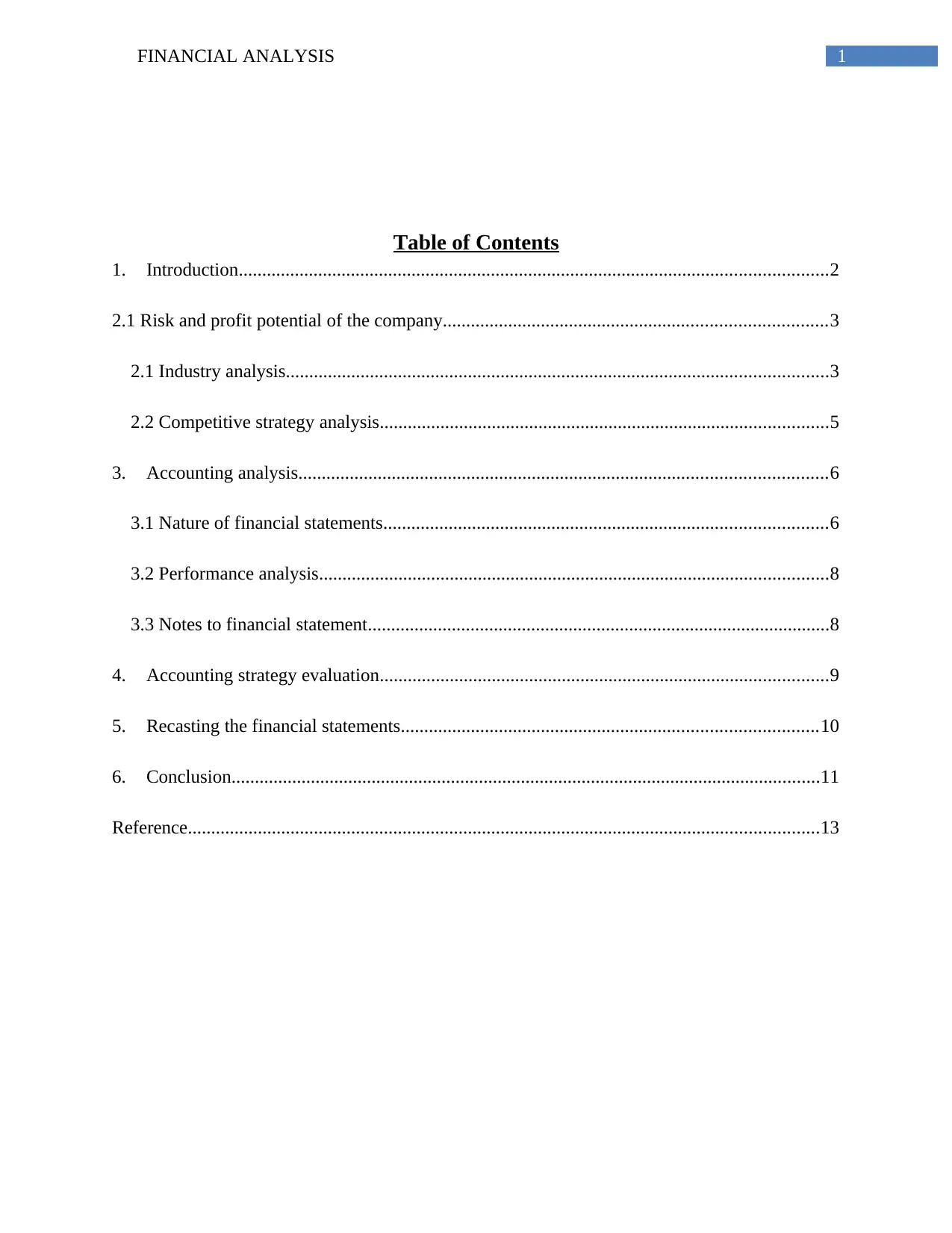
1FINANCIAL ANALYSIS
Table of Contents
1. Introduction..............................................................................................................................2
2.1 Risk and profit potential of the company..................................................................................3
2.1 Industry analysis....................................................................................................................3
2.2 Competitive strategy analysis................................................................................................5
3. Accounting analysis.................................................................................................................6
3.1 Nature of financial statements...............................................................................................6
3.2 Performance analysis.............................................................................................................8
3.3 Notes to financial statement...................................................................................................8
4. Accounting strategy evaluation................................................................................................9
5. Recasting the financial statements.........................................................................................10
6. Conclusion..............................................................................................................................11
Reference.......................................................................................................................................13
Table of Contents
1. Introduction..............................................................................................................................2
2.1 Risk and profit potential of the company..................................................................................3
2.1 Industry analysis....................................................................................................................3
2.2 Competitive strategy analysis................................................................................................5
3. Accounting analysis.................................................................................................................6
3.1 Nature of financial statements...............................................................................................6
3.2 Performance analysis.............................................................................................................8
3.3 Notes to financial statement...................................................................................................8
4. Accounting strategy evaluation................................................................................................9
5. Recasting the financial statements.........................................................................................10
6. Conclusion..............................................................................................................................11
Reference.......................................................................................................................................13
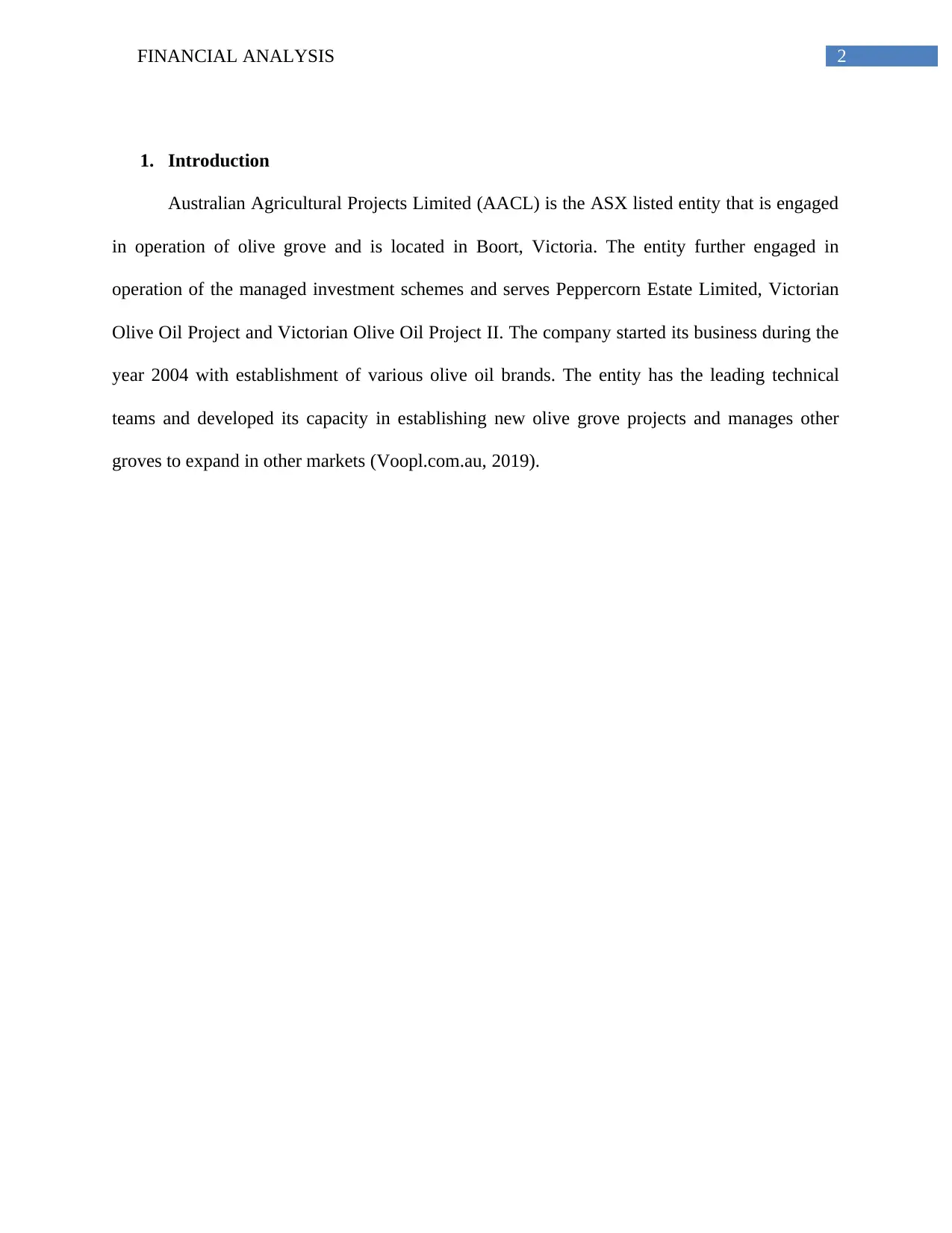
2FINANCIAL ANALYSIS
1. Introduction
Australian Agricultural Projects Limited (AACL) is the ASX listed entity that is engaged
in operation of olive grove and is located in Boort, Victoria. The entity further engaged in
operation of the managed investment schemes and serves Peppercorn Estate Limited, Victorian
Olive Oil Project and Victorian Olive Oil Project II. The company started its business during the
year 2004 with establishment of various olive oil brands. The entity has the leading technical
teams and developed its capacity in establishing new olive grove projects and manages other
groves to expand in other markets (Voopl.com.au, 2019).
1. Introduction
Australian Agricultural Projects Limited (AACL) is the ASX listed entity that is engaged
in operation of olive grove and is located in Boort, Victoria. The entity further engaged in
operation of the managed investment schemes and serves Peppercorn Estate Limited, Victorian
Olive Oil Project and Victorian Olive Oil Project II. The company started its business during the
year 2004 with establishment of various olive oil brands. The entity has the leading technical
teams and developed its capacity in establishing new olive grove projects and manages other
groves to expand in other markets (Voopl.com.au, 2019).
⊘ This is a preview!⊘
Do you want full access?
Subscribe today to unlock all pages.

Trusted by 1+ million students worldwide
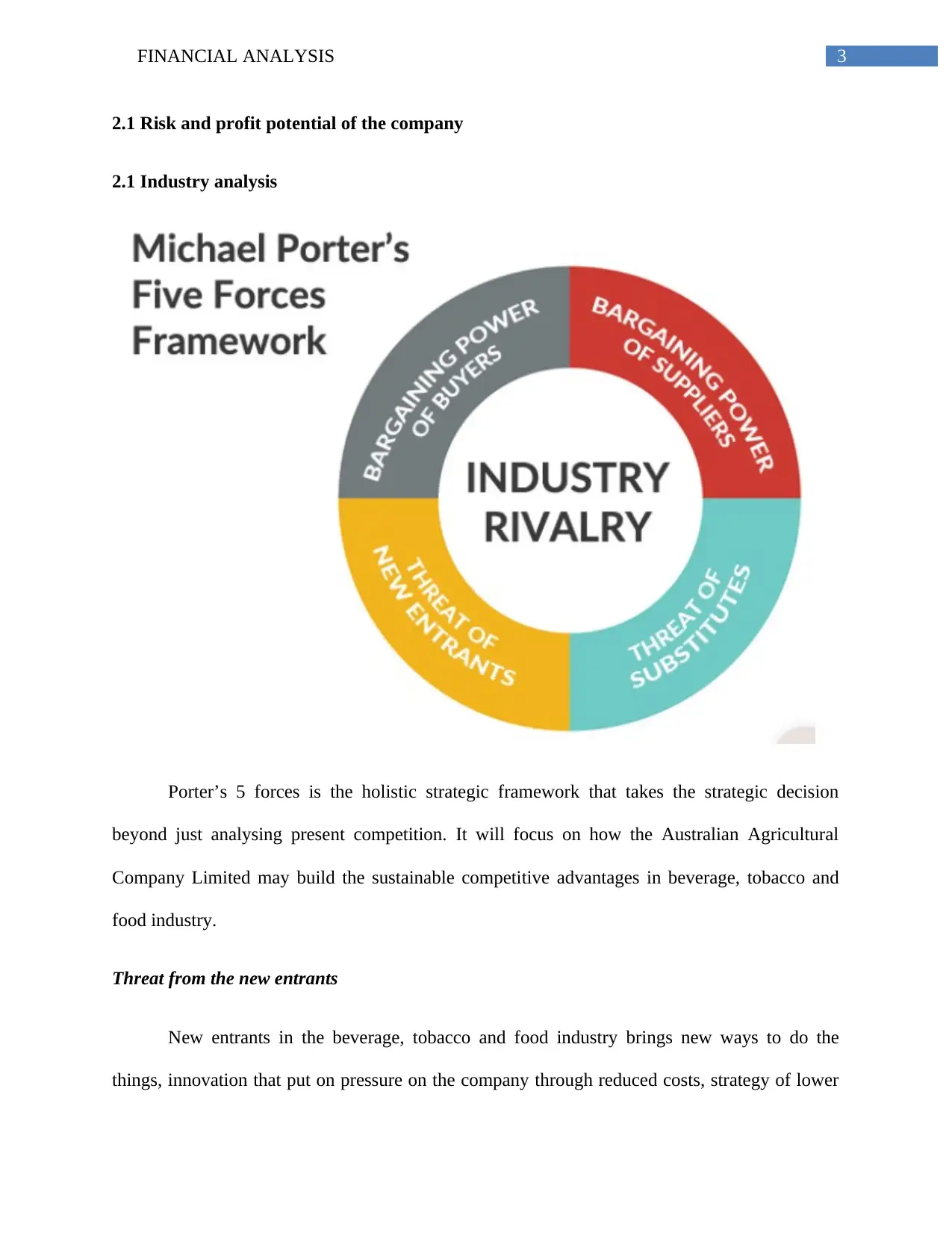
3FINANCIAL ANALYSIS
2.1 Risk and profit potential of the company
2.1 Industry analysis
Porter’s 5 forces is the holistic strategic framework that takes the strategic decision
beyond just analysing present competition. It will focus on how the Australian Agricultural
Company Limited may build the sustainable competitive advantages in beverage, tobacco and
food industry.
Threat from the new entrants
New entrants in the beverage, tobacco and food industry brings new ways to do the
things, innovation that put on pressure on the company through reduced costs, strategy of lower
2.1 Risk and profit potential of the company
2.1 Industry analysis
Porter’s 5 forces is the holistic strategic framework that takes the strategic decision
beyond just analysing present competition. It will focus on how the Australian Agricultural
Company Limited may build the sustainable competitive advantages in beverage, tobacco and
food industry.
Threat from the new entrants
New entrants in the beverage, tobacco and food industry brings new ways to do the
things, innovation that put on pressure on the company through reduced costs, strategy of lower
Paraphrase This Document
Need a fresh take? Get an instant paraphrase of this document with our AI Paraphraser
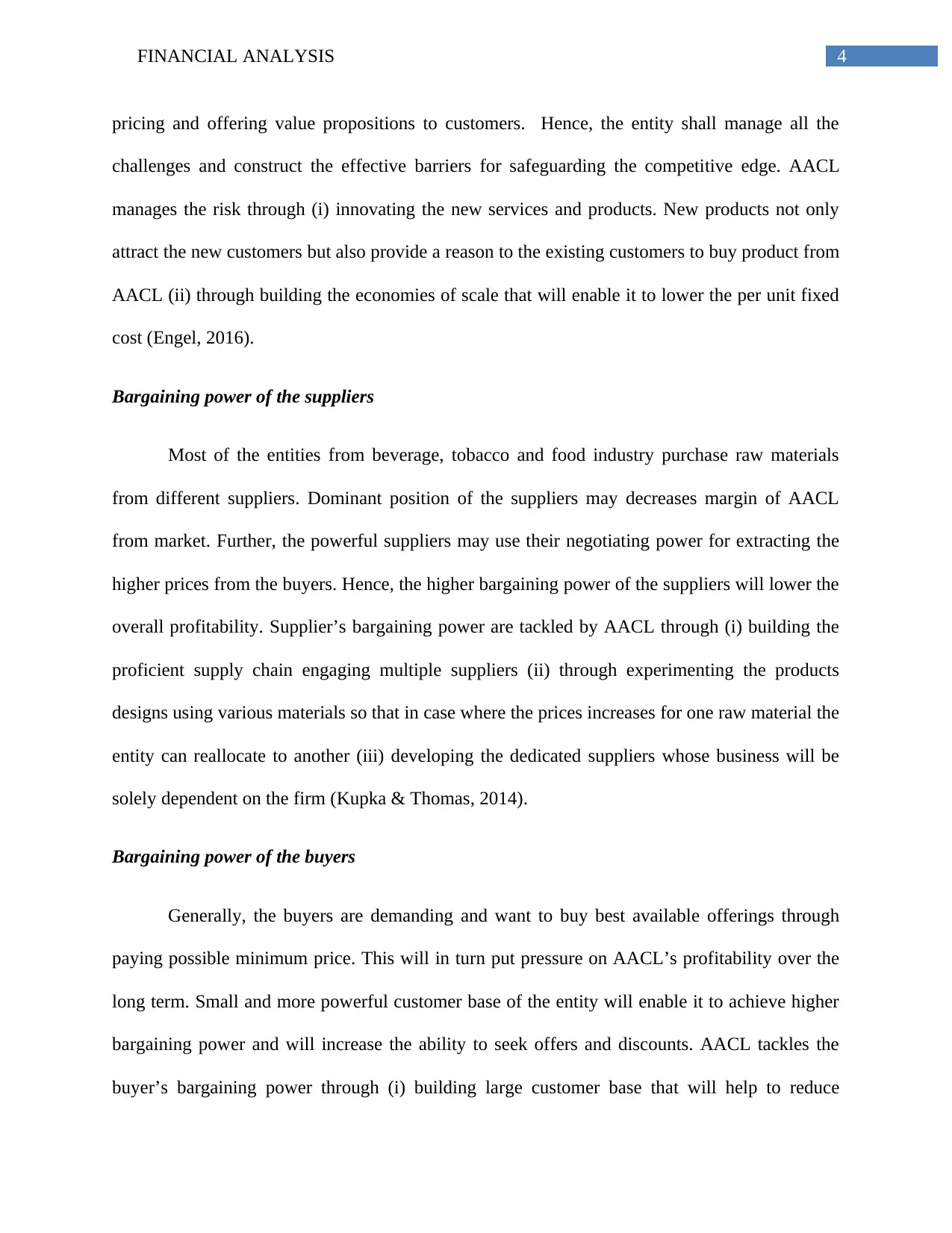
4FINANCIAL ANALYSIS
pricing and offering value propositions to customers. Hence, the entity shall manage all the
challenges and construct the effective barriers for safeguarding the competitive edge. AACL
manages the risk through (i) innovating the new services and products. New products not only
attract the new customers but also provide a reason to the existing customers to buy product from
AACL (ii) through building the economies of scale that will enable it to lower the per unit fixed
cost (Engel, 2016).
Bargaining power of the suppliers
Most of the entities from beverage, tobacco and food industry purchase raw materials
from different suppliers. Dominant position of the suppliers may decreases margin of AACL
from market. Further, the powerful suppliers may use their negotiating power for extracting the
higher prices from the buyers. Hence, the higher bargaining power of the suppliers will lower the
overall profitability. Supplier’s bargaining power are tackled by AACL through (i) building the
proficient supply chain engaging multiple suppliers (ii) through experimenting the products
designs using various materials so that in case where the prices increases for one raw material the
entity can reallocate to another (iii) developing the dedicated suppliers whose business will be
solely dependent on the firm (Kupka & Thomas, 2014).
Bargaining power of the buyers
Generally, the buyers are demanding and want to buy best available offerings through
paying possible minimum price. This will in turn put pressure on AACL’s profitability over the
long term. Small and more powerful customer base of the entity will enable it to achieve higher
bargaining power and will increase the ability to seek offers and discounts. AACL tackles the
buyer’s bargaining power through (i) building large customer base that will help to reduce
pricing and offering value propositions to customers. Hence, the entity shall manage all the
challenges and construct the effective barriers for safeguarding the competitive edge. AACL
manages the risk through (i) innovating the new services and products. New products not only
attract the new customers but also provide a reason to the existing customers to buy product from
AACL (ii) through building the economies of scale that will enable it to lower the per unit fixed
cost (Engel, 2016).
Bargaining power of the suppliers
Most of the entities from beverage, tobacco and food industry purchase raw materials
from different suppliers. Dominant position of the suppliers may decreases margin of AACL
from market. Further, the powerful suppliers may use their negotiating power for extracting the
higher prices from the buyers. Hence, the higher bargaining power of the suppliers will lower the
overall profitability. Supplier’s bargaining power are tackled by AACL through (i) building the
proficient supply chain engaging multiple suppliers (ii) through experimenting the products
designs using various materials so that in case where the prices increases for one raw material the
entity can reallocate to another (iii) developing the dedicated suppliers whose business will be
solely dependent on the firm (Kupka & Thomas, 2014).
Bargaining power of the buyers
Generally, the buyers are demanding and want to buy best available offerings through
paying possible minimum price. This will in turn put pressure on AACL’s profitability over the
long term. Small and more powerful customer base of the entity will enable it to achieve higher
bargaining power and will increase the ability to seek offers and discounts. AACL tackles the
buyer’s bargaining power through (i) building large customer base that will help to reduce
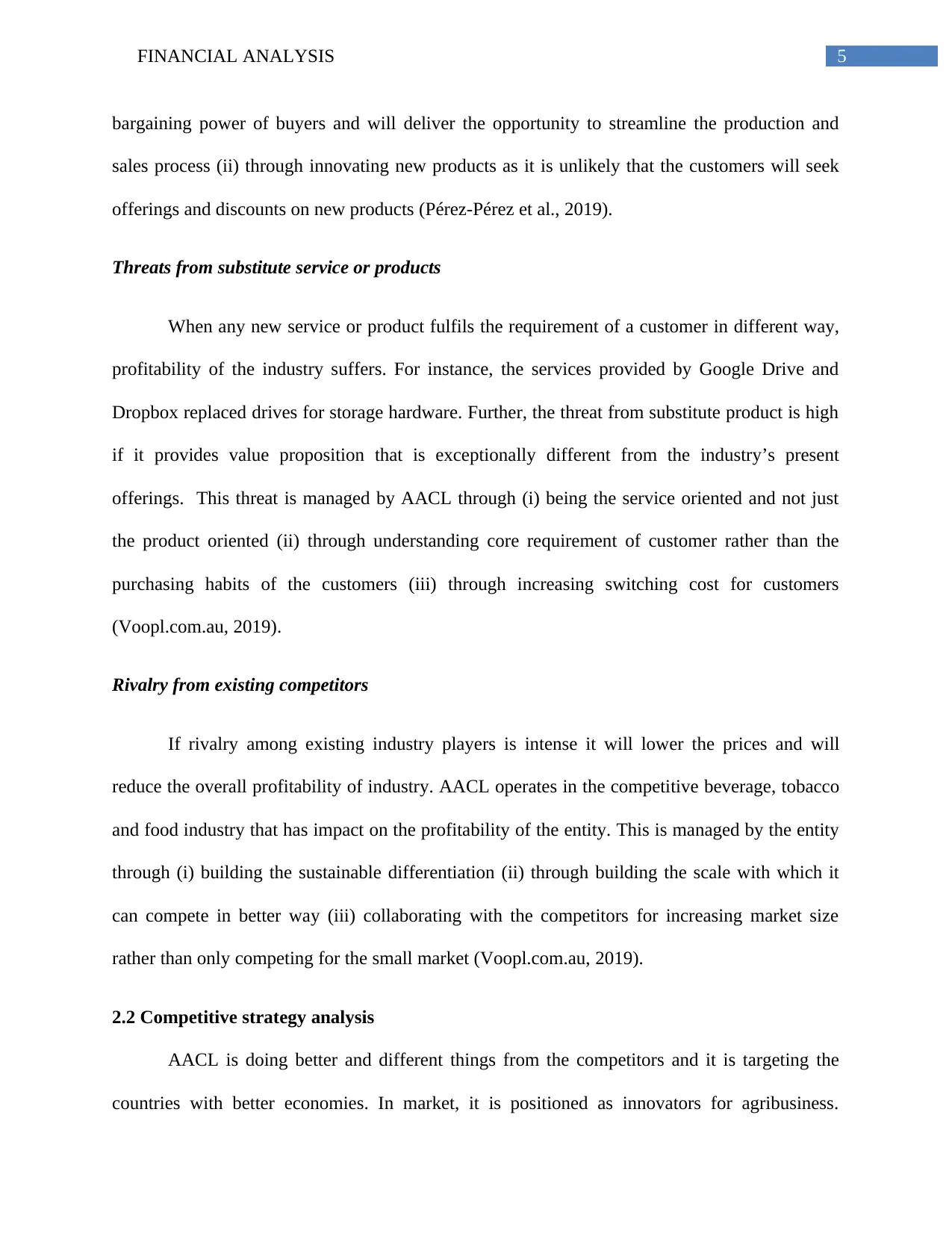
5FINANCIAL ANALYSIS
bargaining power of buyers and will deliver the opportunity to streamline the production and
sales process (ii) through innovating new products as it is unlikely that the customers will seek
offerings and discounts on new products (Pérez-Pérez et al., 2019).
Threats from substitute service or products
When any new service or product fulfils the requirement of a customer in different way,
profitability of the industry suffers. For instance, the services provided by Google Drive and
Dropbox replaced drives for storage hardware. Further, the threat from substitute product is high
if it provides value proposition that is exceptionally different from the industry’s present
offerings. This threat is managed by AACL through (i) being the service oriented and not just
the product oriented (ii) through understanding core requirement of customer rather than the
purchasing habits of the customers (iii) through increasing switching cost for customers
(Voopl.com.au, 2019).
Rivalry from existing competitors
If rivalry among existing industry players is intense it will lower the prices and will
reduce the overall profitability of industry. AACL operates in the competitive beverage, tobacco
and food industry that has impact on the profitability of the entity. This is managed by the entity
through (i) building the sustainable differentiation (ii) through building the scale with which it
can compete in better way (iii) collaborating with the competitors for increasing market size
rather than only competing for the small market (Voopl.com.au, 2019).
2.2 Competitive strategy analysis
AACL is doing better and different things from the competitors and it is targeting the
countries with better economies. In market, it is positioned as innovators for agribusiness.
bargaining power of buyers and will deliver the opportunity to streamline the production and
sales process (ii) through innovating new products as it is unlikely that the customers will seek
offerings and discounts on new products (Pérez-Pérez et al., 2019).
Threats from substitute service or products
When any new service or product fulfils the requirement of a customer in different way,
profitability of the industry suffers. For instance, the services provided by Google Drive and
Dropbox replaced drives for storage hardware. Further, the threat from substitute product is high
if it provides value proposition that is exceptionally different from the industry’s present
offerings. This threat is managed by AACL through (i) being the service oriented and not just
the product oriented (ii) through understanding core requirement of customer rather than the
purchasing habits of the customers (iii) through increasing switching cost for customers
(Voopl.com.au, 2019).
Rivalry from existing competitors
If rivalry among existing industry players is intense it will lower the prices and will
reduce the overall profitability of industry. AACL operates in the competitive beverage, tobacco
and food industry that has impact on the profitability of the entity. This is managed by the entity
through (i) building the sustainable differentiation (ii) through building the scale with which it
can compete in better way (iii) collaborating with the competitors for increasing market size
rather than only competing for the small market (Voopl.com.au, 2019).
2.2 Competitive strategy analysis
AACL is doing better and different things from the competitors and it is targeting the
countries with better economies. In market, it is positioned as innovators for agribusiness.
⊘ This is a preview!⊘
Do you want full access?
Subscribe today to unlock all pages.

Trusted by 1+ million students worldwide
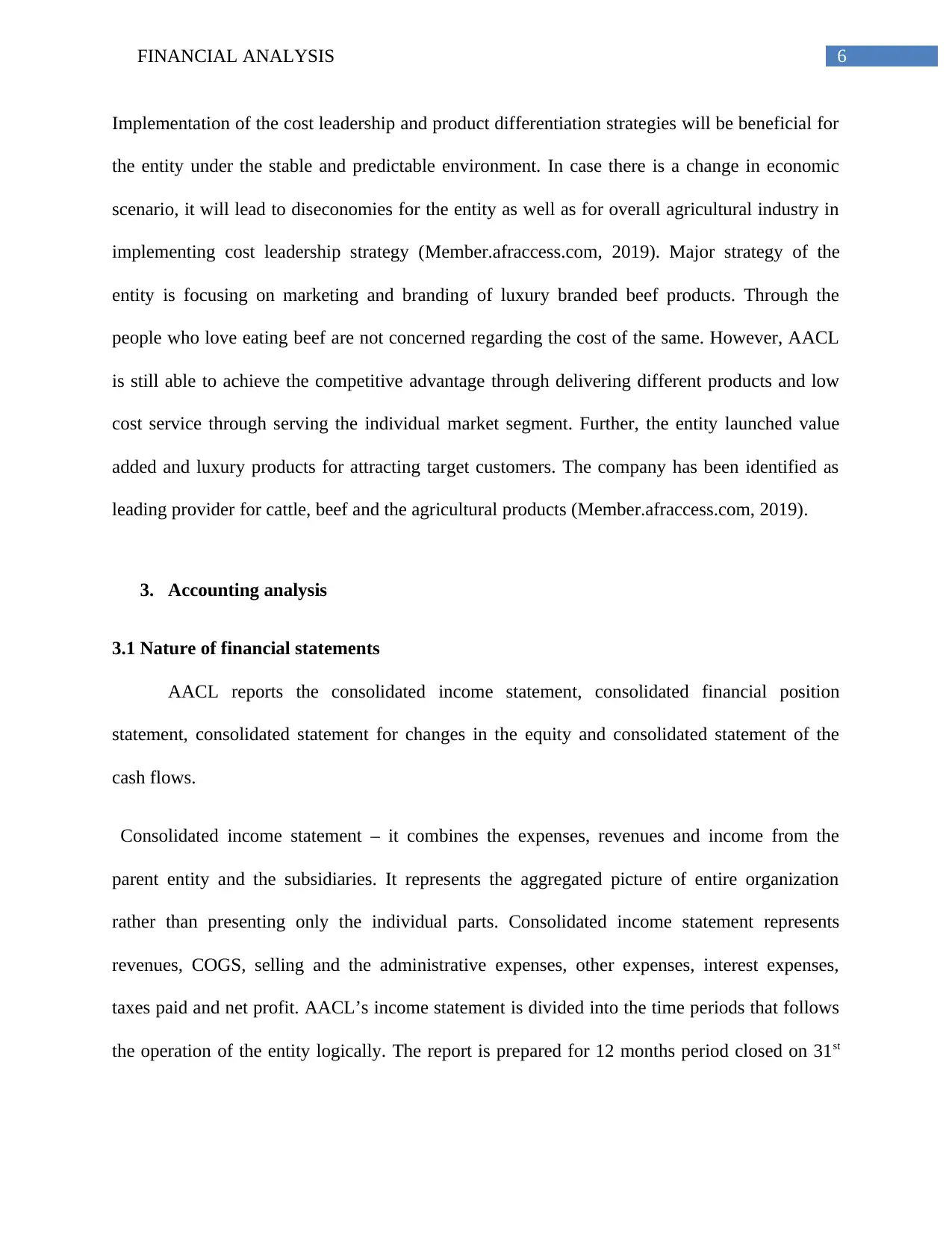
6FINANCIAL ANALYSIS
Implementation of the cost leadership and product differentiation strategies will be beneficial for
the entity under the stable and predictable environment. In case there is a change in economic
scenario, it will lead to diseconomies for the entity as well as for overall agricultural industry in
implementing cost leadership strategy (Member.afraccess.com, 2019). Major strategy of the
entity is focusing on marketing and branding of luxury branded beef products. Through the
people who love eating beef are not concerned regarding the cost of the same. However, AACL
is still able to achieve the competitive advantage through delivering different products and low
cost service through serving the individual market segment. Further, the entity launched value
added and luxury products for attracting target customers. The company has been identified as
leading provider for cattle, beef and the agricultural products (Member.afraccess.com, 2019).
3. Accounting analysis
3.1 Nature of financial statements
AACL reports the consolidated income statement, consolidated financial position
statement, consolidated statement for changes in the equity and consolidated statement of the
cash flows.
Consolidated income statement – it combines the expenses, revenues and income from the
parent entity and the subsidiaries. It represents the aggregated picture of entire organization
rather than presenting only the individual parts. Consolidated income statement represents
revenues, COGS, selling and the administrative expenses, other expenses, interest expenses,
taxes paid and net profit. AACL’s income statement is divided into the time periods that follows
the operation of the entity logically. The report is prepared for 12 months period closed on 31st
Implementation of the cost leadership and product differentiation strategies will be beneficial for
the entity under the stable and predictable environment. In case there is a change in economic
scenario, it will lead to diseconomies for the entity as well as for overall agricultural industry in
implementing cost leadership strategy (Member.afraccess.com, 2019). Major strategy of the
entity is focusing on marketing and branding of luxury branded beef products. Through the
people who love eating beef are not concerned regarding the cost of the same. However, AACL
is still able to achieve the competitive advantage through delivering different products and low
cost service through serving the individual market segment. Further, the entity launched value
added and luxury products for attracting target customers. The company has been identified as
leading provider for cattle, beef and the agricultural products (Member.afraccess.com, 2019).
3. Accounting analysis
3.1 Nature of financial statements
AACL reports the consolidated income statement, consolidated financial position
statement, consolidated statement for changes in the equity and consolidated statement of the
cash flows.
Consolidated income statement – it combines the expenses, revenues and income from the
parent entity and the subsidiaries. It represents the aggregated picture of entire organization
rather than presenting only the individual parts. Consolidated income statement represents
revenues, COGS, selling and the administrative expenses, other expenses, interest expenses,
taxes paid and net profit. AACL’s income statement is divided into the time periods that follows
the operation of the entity logically. The report is prepared for 12 months period closed on 31st
Paraphrase This Document
Need a fresh take? Get an instant paraphrase of this document with our AI Paraphraser
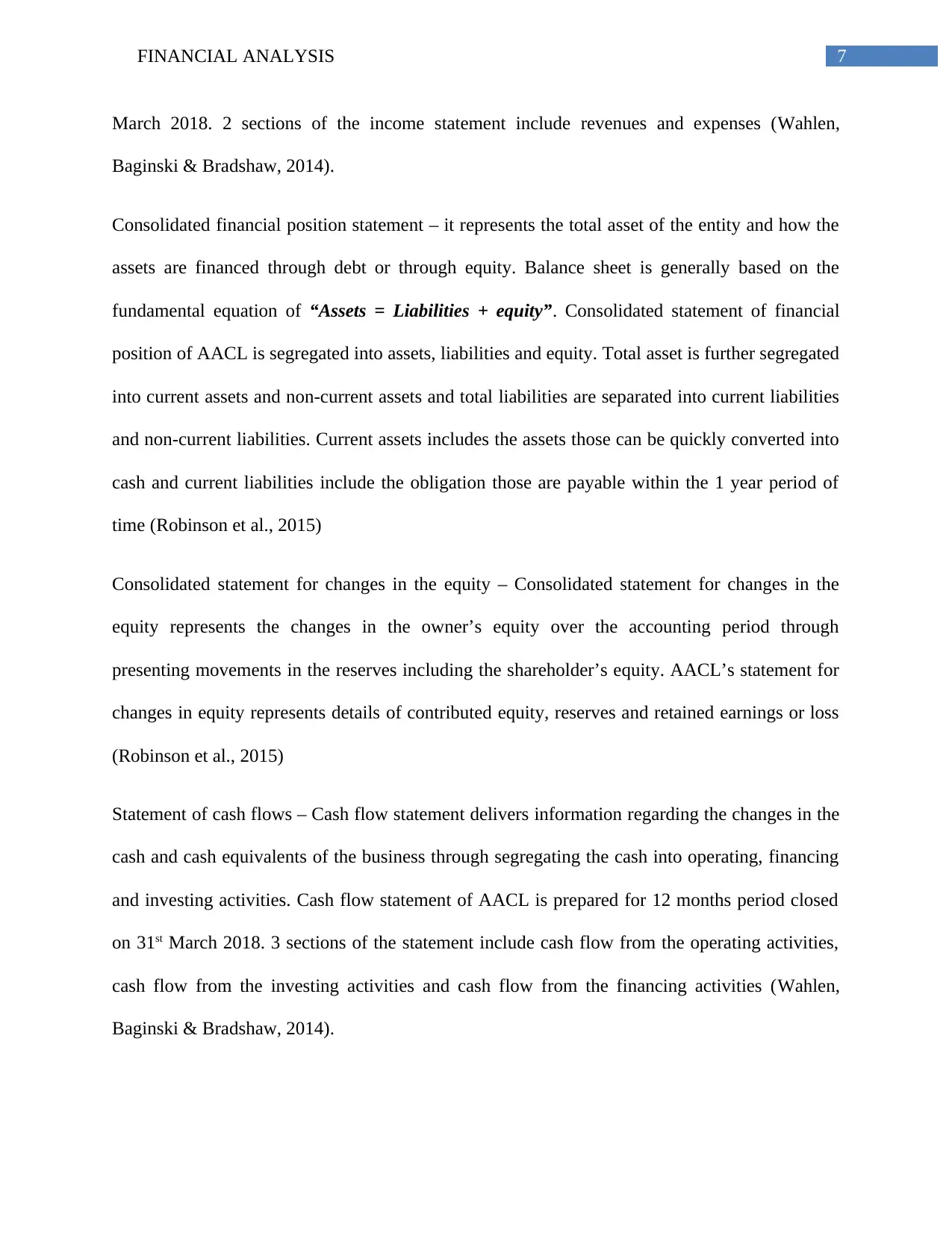
7FINANCIAL ANALYSIS
March 2018. 2 sections of the income statement include revenues and expenses (Wahlen,
Baginski & Bradshaw, 2014).
Consolidated financial position statement – it represents the total asset of the entity and how the
assets are financed through debt or through equity. Balance sheet is generally based on the
fundamental equation of “Assets = Liabilities + equity”. Consolidated statement of financial
position of AACL is segregated into assets, liabilities and equity. Total asset is further segregated
into current assets and non-current assets and total liabilities are separated into current liabilities
and non-current liabilities. Current assets includes the assets those can be quickly converted into
cash and current liabilities include the obligation those are payable within the 1 year period of
time (Robinson et al., 2015)
Consolidated statement for changes in the equity – Consolidated statement for changes in the
equity represents the changes in the owner’s equity over the accounting period through
presenting movements in the reserves including the shareholder’s equity. AACL’s statement for
changes in equity represents details of contributed equity, reserves and retained earnings or loss
(Robinson et al., 2015)
Statement of cash flows – Cash flow statement delivers information regarding the changes in the
cash and cash equivalents of the business through segregating the cash into operating, financing
and investing activities. Cash flow statement of AACL is prepared for 12 months period closed
on 31st March 2018. 3 sections of the statement include cash flow from the operating activities,
cash flow from the investing activities and cash flow from the financing activities (Wahlen,
Baginski & Bradshaw, 2014).
March 2018. 2 sections of the income statement include revenues and expenses (Wahlen,
Baginski & Bradshaw, 2014).
Consolidated financial position statement – it represents the total asset of the entity and how the
assets are financed through debt or through equity. Balance sheet is generally based on the
fundamental equation of “Assets = Liabilities + equity”. Consolidated statement of financial
position of AACL is segregated into assets, liabilities and equity. Total asset is further segregated
into current assets and non-current assets and total liabilities are separated into current liabilities
and non-current liabilities. Current assets includes the assets those can be quickly converted into
cash and current liabilities include the obligation those are payable within the 1 year period of
time (Robinson et al., 2015)
Consolidated statement for changes in the equity – Consolidated statement for changes in the
equity represents the changes in the owner’s equity over the accounting period through
presenting movements in the reserves including the shareholder’s equity. AACL’s statement for
changes in equity represents details of contributed equity, reserves and retained earnings or loss
(Robinson et al., 2015)
Statement of cash flows – Cash flow statement delivers information regarding the changes in the
cash and cash equivalents of the business through segregating the cash into operating, financing
and investing activities. Cash flow statement of AACL is prepared for 12 months period closed
on 31st March 2018. 3 sections of the statement include cash flow from the operating activities,
cash flow from the investing activities and cash flow from the financing activities (Wahlen,
Baginski & Bradshaw, 2014).
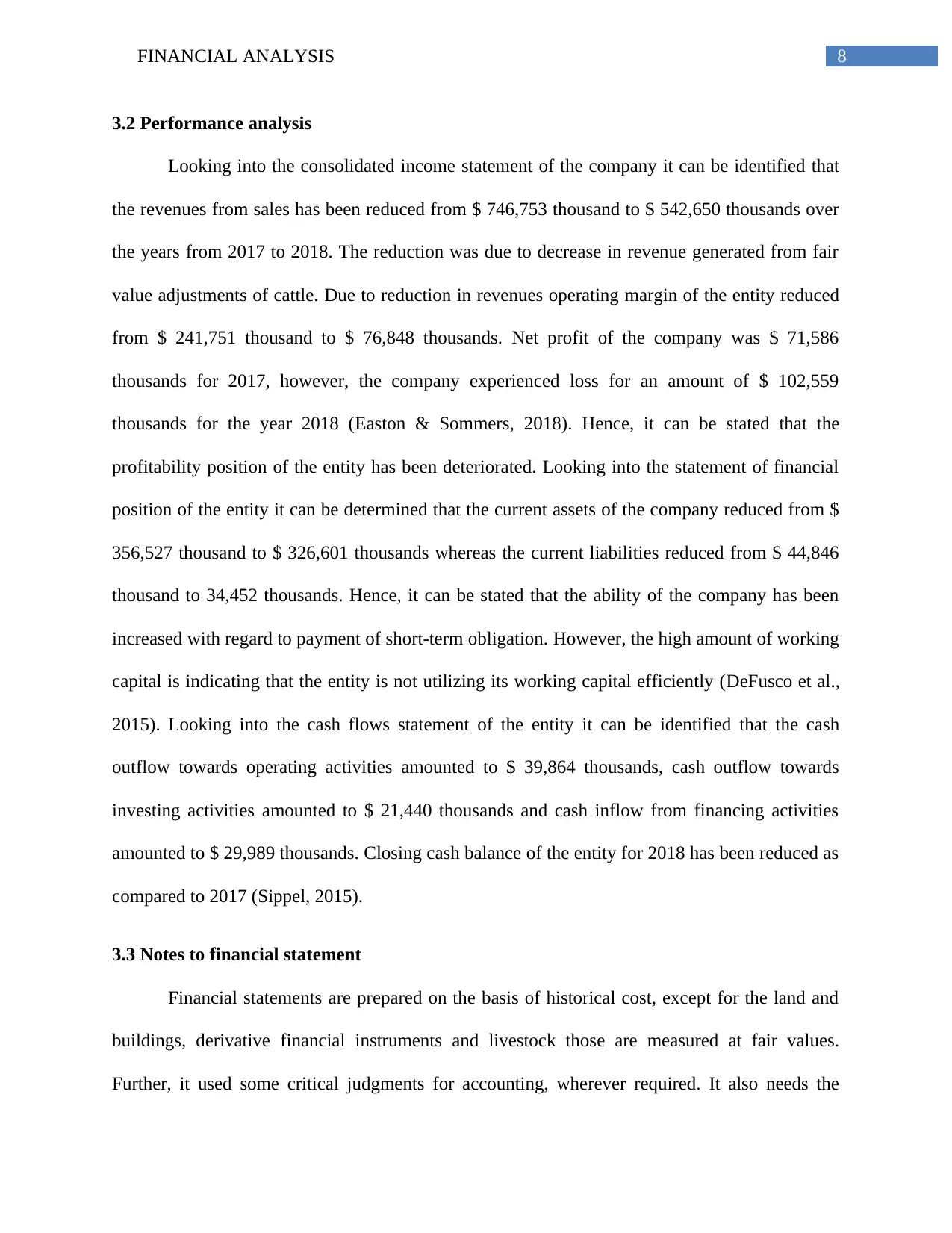
8FINANCIAL ANALYSIS
3.2 Performance analysis
Looking into the consolidated income statement of the company it can be identified that
the revenues from sales has been reduced from $ 746,753 thousand to $ 542,650 thousands over
the years from 2017 to 2018. The reduction was due to decrease in revenue generated from fair
value adjustments of cattle. Due to reduction in revenues operating margin of the entity reduced
from $ 241,751 thousand to $ 76,848 thousands. Net profit of the company was $ 71,586
thousands for 2017, however, the company experienced loss for an amount of $ 102,559
thousands for the year 2018 (Easton & Sommers, 2018). Hence, it can be stated that the
profitability position of the entity has been deteriorated. Looking into the statement of financial
position of the entity it can be determined that the current assets of the company reduced from $
356,527 thousand to $ 326,601 thousands whereas the current liabilities reduced from $ 44,846
thousand to 34,452 thousands. Hence, it can be stated that the ability of the company has been
increased with regard to payment of short-term obligation. However, the high amount of working
capital is indicating that the entity is not utilizing its working capital efficiently (DeFusco et al.,
2015). Looking into the cash flows statement of the entity it can be identified that the cash
outflow towards operating activities amounted to $ 39,864 thousands, cash outflow towards
investing activities amounted to $ 21,440 thousands and cash inflow from financing activities
amounted to $ 29,989 thousands. Closing cash balance of the entity for 2018 has been reduced as
compared to 2017 (Sippel, 2015).
3.3 Notes to financial statement
Financial statements are prepared on the basis of historical cost, except for the land and
buildings, derivative financial instruments and livestock those are measured at fair values.
Further, it used some critical judgments for accounting, wherever required. It also needs the
3.2 Performance analysis
Looking into the consolidated income statement of the company it can be identified that
the revenues from sales has been reduced from $ 746,753 thousand to $ 542,650 thousands over
the years from 2017 to 2018. The reduction was due to decrease in revenue generated from fair
value adjustments of cattle. Due to reduction in revenues operating margin of the entity reduced
from $ 241,751 thousand to $ 76,848 thousands. Net profit of the company was $ 71,586
thousands for 2017, however, the company experienced loss for an amount of $ 102,559
thousands for the year 2018 (Easton & Sommers, 2018). Hence, it can be stated that the
profitability position of the entity has been deteriorated. Looking into the statement of financial
position of the entity it can be determined that the current assets of the company reduced from $
356,527 thousand to $ 326,601 thousands whereas the current liabilities reduced from $ 44,846
thousand to 34,452 thousands. Hence, it can be stated that the ability of the company has been
increased with regard to payment of short-term obligation. However, the high amount of working
capital is indicating that the entity is not utilizing its working capital efficiently (DeFusco et al.,
2015). Looking into the cash flows statement of the entity it can be identified that the cash
outflow towards operating activities amounted to $ 39,864 thousands, cash outflow towards
investing activities amounted to $ 21,440 thousands and cash inflow from financing activities
amounted to $ 29,989 thousands. Closing cash balance of the entity for 2018 has been reduced as
compared to 2017 (Sippel, 2015).
3.3 Notes to financial statement
Financial statements are prepared on the basis of historical cost, except for the land and
buildings, derivative financial instruments and livestock those are measured at fair values.
Further, it used some critical judgments for accounting, wherever required. It also needs the
⊘ This is a preview!⊘
Do you want full access?
Subscribe today to unlock all pages.

Trusted by 1+ million students worldwide
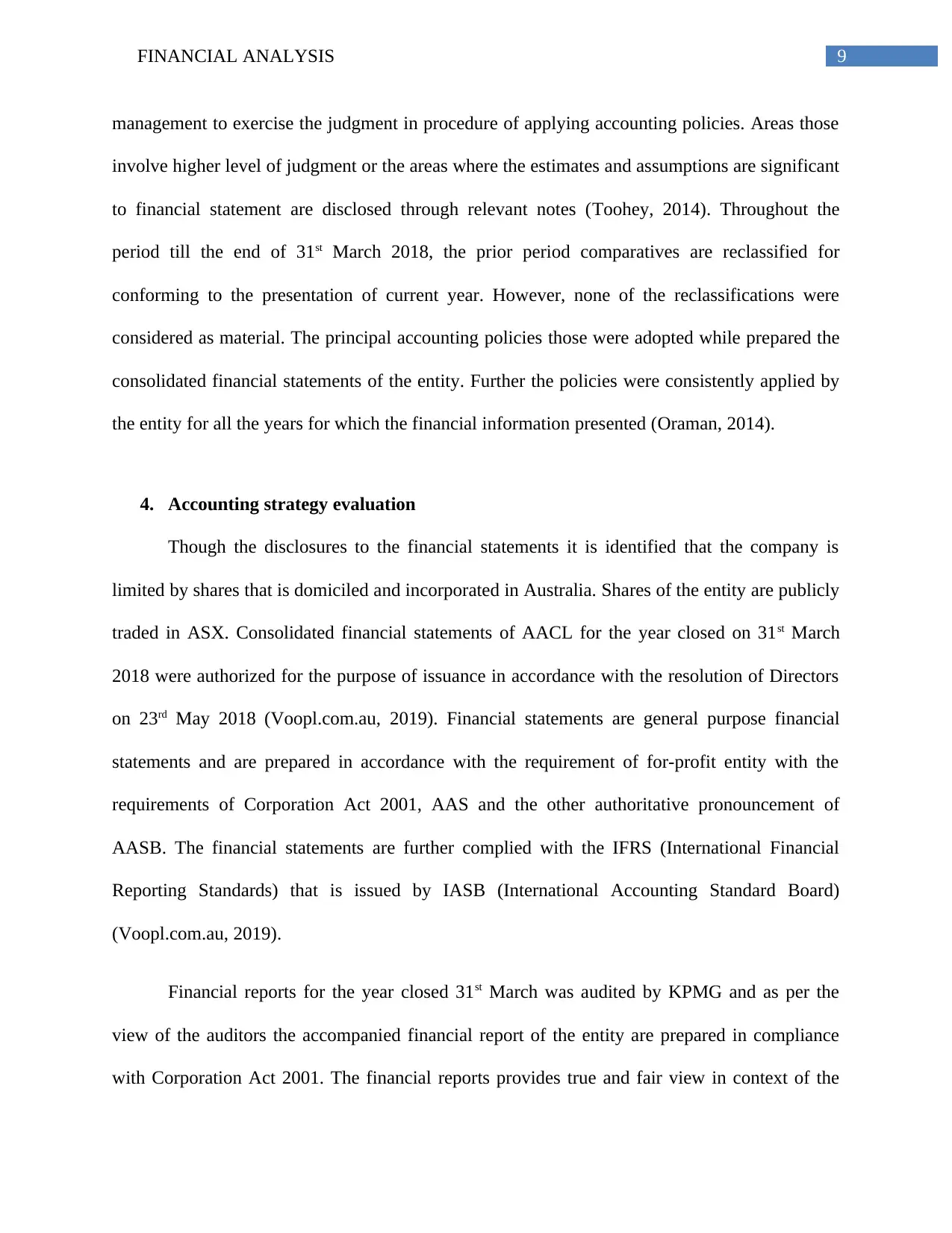
9FINANCIAL ANALYSIS
management to exercise the judgment in procedure of applying accounting policies. Areas those
involve higher level of judgment or the areas where the estimates and assumptions are significant
to financial statement are disclosed through relevant notes (Toohey, 2014). Throughout the
period till the end of 31st March 2018, the prior period comparatives are reclassified for
conforming to the presentation of current year. However, none of the reclassifications were
considered as material. The principal accounting policies those were adopted while prepared the
consolidated financial statements of the entity. Further the policies were consistently applied by
the entity for all the years for which the financial information presented (Oraman, 2014).
4. Accounting strategy evaluation
Though the disclosures to the financial statements it is identified that the company is
limited by shares that is domiciled and incorporated in Australia. Shares of the entity are publicly
traded in ASX. Consolidated financial statements of AACL for the year closed on 31st March
2018 were authorized for the purpose of issuance in accordance with the resolution of Directors
on 23rd May 2018 (Voopl.com.au, 2019). Financial statements are general purpose financial
statements and are prepared in accordance with the requirement of for-profit entity with the
requirements of Corporation Act 2001, AAS and the other authoritative pronouncement of
AASB. The financial statements are further complied with the IFRS (International Financial
Reporting Standards) that is issued by IASB (International Accounting Standard Board)
(Voopl.com.au, 2019).
Financial reports for the year closed 31st March was audited by KPMG and as per the
view of the auditors the accompanied financial report of the entity are prepared in compliance
with Corporation Act 2001. The financial reports provides true and fair view in context of the
management to exercise the judgment in procedure of applying accounting policies. Areas those
involve higher level of judgment or the areas where the estimates and assumptions are significant
to financial statement are disclosed through relevant notes (Toohey, 2014). Throughout the
period till the end of 31st March 2018, the prior period comparatives are reclassified for
conforming to the presentation of current year. However, none of the reclassifications were
considered as material. The principal accounting policies those were adopted while prepared the
consolidated financial statements of the entity. Further the policies were consistently applied by
the entity for all the years for which the financial information presented (Oraman, 2014).
4. Accounting strategy evaluation
Though the disclosures to the financial statements it is identified that the company is
limited by shares that is domiciled and incorporated in Australia. Shares of the entity are publicly
traded in ASX. Consolidated financial statements of AACL for the year closed on 31st March
2018 were authorized for the purpose of issuance in accordance with the resolution of Directors
on 23rd May 2018 (Voopl.com.au, 2019). Financial statements are general purpose financial
statements and are prepared in accordance with the requirement of for-profit entity with the
requirements of Corporation Act 2001, AAS and the other authoritative pronouncement of
AASB. The financial statements are further complied with the IFRS (International Financial
Reporting Standards) that is issued by IASB (International Accounting Standard Board)
(Voopl.com.au, 2019).
Financial reports for the year closed 31st March was audited by KPMG and as per the
view of the auditors the accompanied financial report of the entity are prepared in compliance
with Corporation Act 2001. The financial reports provides true and fair view in context of the
Paraphrase This Document
Need a fresh take? Get an instant paraphrase of this document with our AI Paraphraser
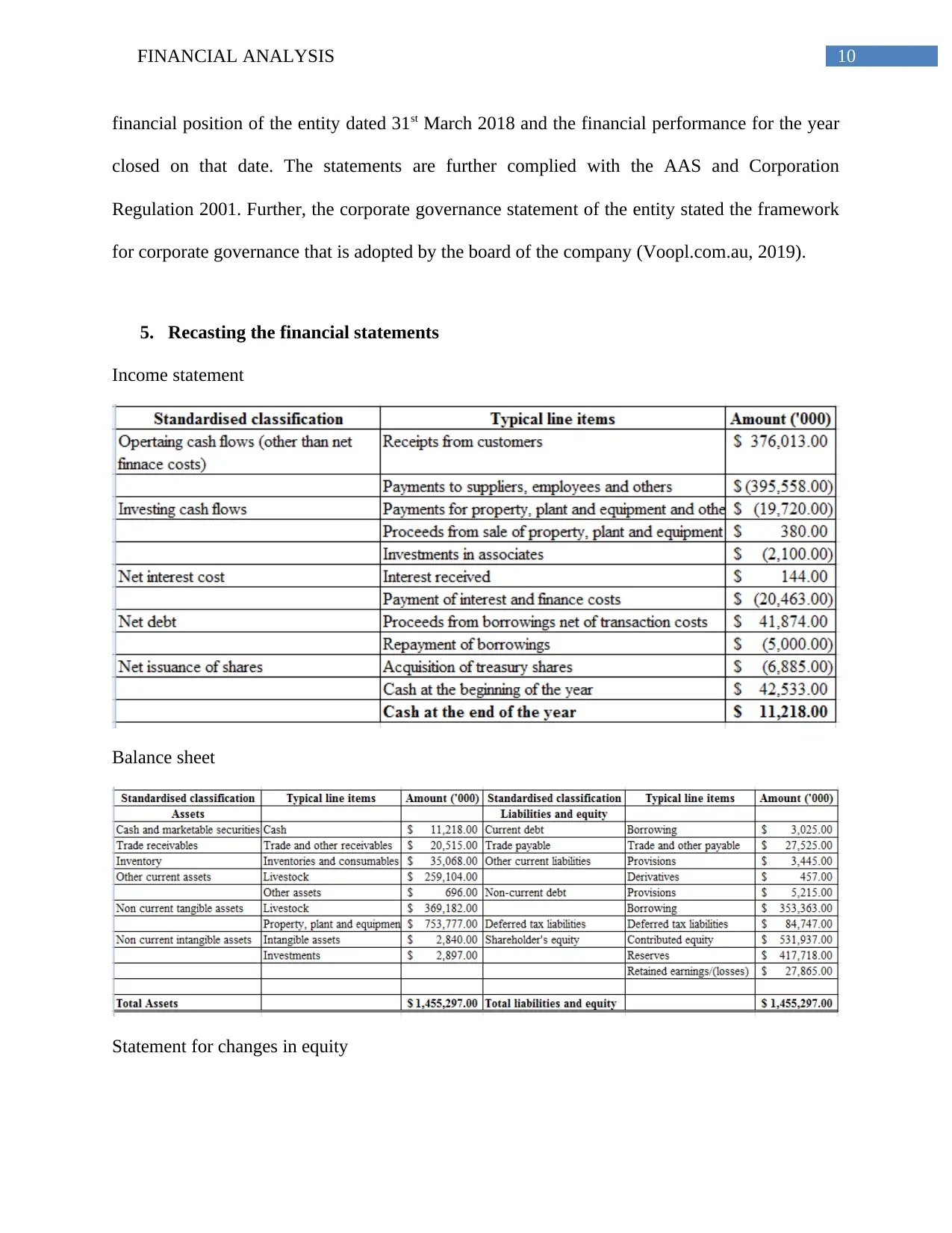
10FINANCIAL ANALYSIS
financial position of the entity dated 31st March 2018 and the financial performance for the year
closed on that date. The statements are further complied with the AAS and Corporation
Regulation 2001. Further, the corporate governance statement of the entity stated the framework
for corporate governance that is adopted by the board of the company (Voopl.com.au, 2019).
5. Recasting the financial statements
Income statement
Balance sheet
Statement for changes in equity
financial position of the entity dated 31st March 2018 and the financial performance for the year
closed on that date. The statements are further complied with the AAS and Corporation
Regulation 2001. Further, the corporate governance statement of the entity stated the framework
for corporate governance that is adopted by the board of the company (Voopl.com.au, 2019).
5. Recasting the financial statements
Income statement
Balance sheet
Statement for changes in equity
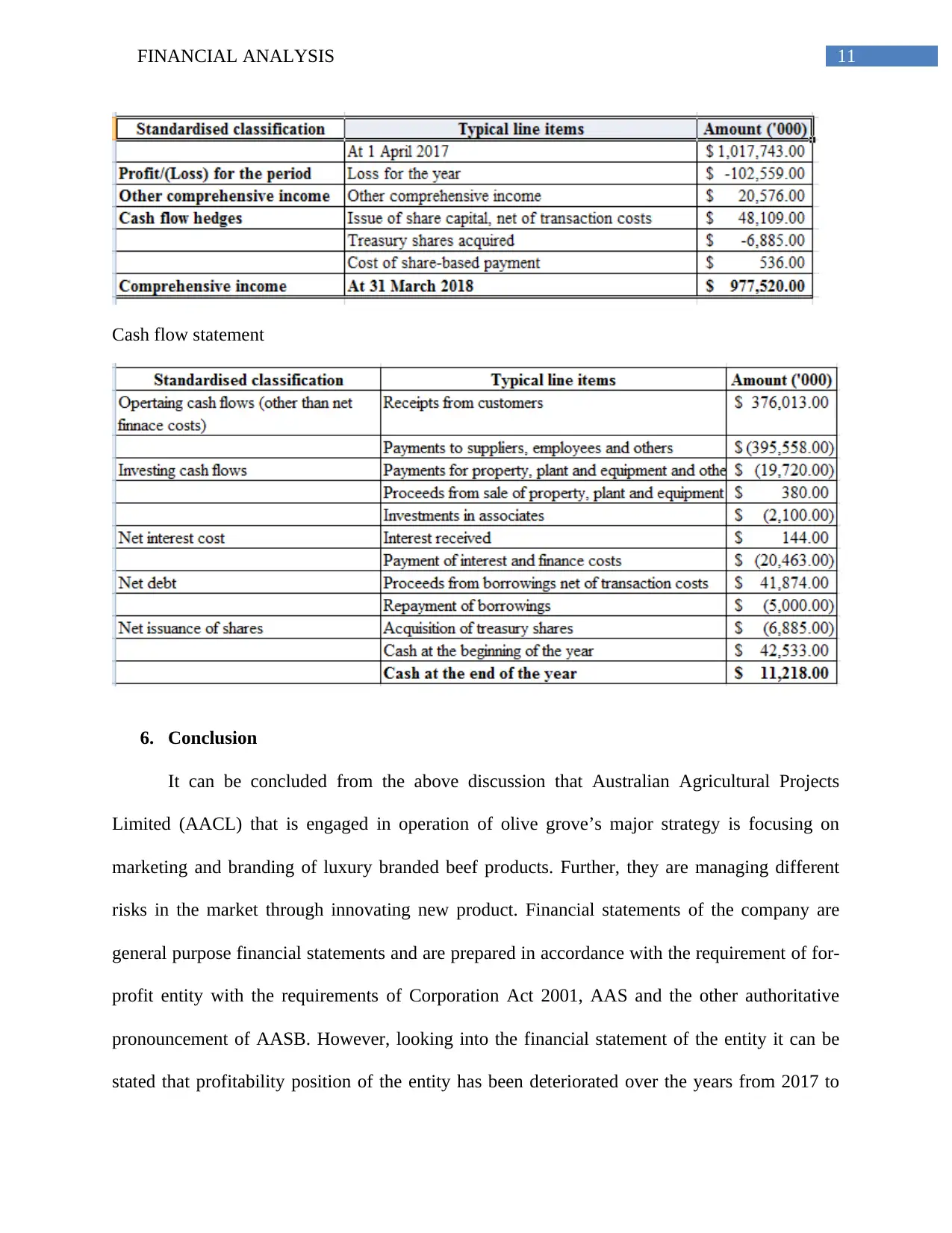
11FINANCIAL ANALYSIS
Cash flow statement
6. Conclusion
It can be concluded from the above discussion that Australian Agricultural Projects
Limited (AACL) that is engaged in operation of olive grove’s major strategy is focusing on
marketing and branding of luxury branded beef products. Further, they are managing different
risks in the market through innovating new product. Financial statements of the company are
general purpose financial statements and are prepared in accordance with the requirement of for-
profit entity with the requirements of Corporation Act 2001, AAS and the other authoritative
pronouncement of AASB. However, looking into the financial statement of the entity it can be
stated that profitability position of the entity has been deteriorated over the years from 2017 to
Cash flow statement
6. Conclusion
It can be concluded from the above discussion that Australian Agricultural Projects
Limited (AACL) that is engaged in operation of olive grove’s major strategy is focusing on
marketing and branding of luxury branded beef products. Further, they are managing different
risks in the market through innovating new product. Financial statements of the company are
general purpose financial statements and are prepared in accordance with the requirement of for-
profit entity with the requirements of Corporation Act 2001, AAS and the other authoritative
pronouncement of AASB. However, looking into the financial statement of the entity it can be
stated that profitability position of the entity has been deteriorated over the years from 2017 to
⊘ This is a preview!⊘
Do you want full access?
Subscribe today to unlock all pages.

Trusted by 1+ million students worldwide
1 out of 15
Related Documents
Your All-in-One AI-Powered Toolkit for Academic Success.
+13062052269
info@desklib.com
Available 24*7 on WhatsApp / Email
![[object Object]](/_next/static/media/star-bottom.7253800d.svg)
Unlock your academic potential
Copyright © 2020–2025 A2Z Services. All Rights Reserved. Developed and managed by ZUCOL.





